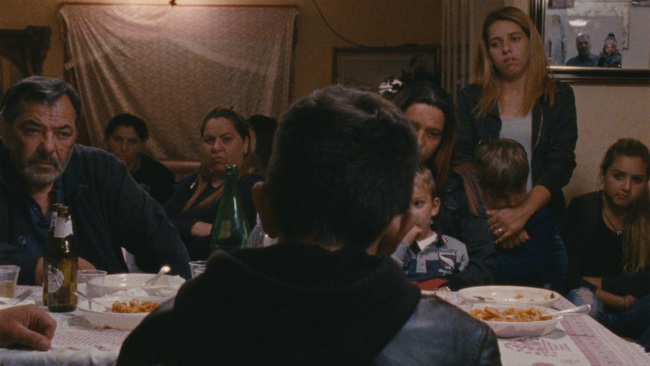Cannes 2017: Jonas Carpagnino’s A Ciambra

“Neo-realism isn’t necessarily a genre built for star turns,” writes Guy Lodge for Variety, “but director Jonas Carpignano happened upon one anyway in his debut Mediterranea: Then-preteen Pio Amato wasn’t the lead in that accomplished, affecting refugee drama, but his spiky, wily turn as a Romani artful dodger in the Calabrian coastal town of Gioia Tauro was a bright, skittering firework in its margins. It comes as no surprise, then, that Carpignano has placed Pio center-stage for his similarly empathetic follow-up A Ciambra, weaving the charismatic kid’s tough coming-of-age narrative into a broader study of poverty and racial prejudice on the fringes of Italian society.”
“Sorely lacking the energy that made Mediterranea such a vital shot in the arm, A Ciambra is a half-step backward for Carpignano, whose clear sense of place is too often hampered by shapeless plot,” finds IndieWire’s David Ehrlich. “Not that it matters all that much when you’ve got a protagonist as pure and watchable as Pio Amato. Effectively playing a version of himself, Pio is a gawky 14-year-old who’s very ready to graduate from the awkward purgatory of adolescence. He’s old enough to recognize that he’s growing up in a punitively tribalistic environment, but not old enough to do anything about it.”
“While it’s not mandatory to have seen Mediterranea, familiarity with that film adds emotional resonance to this latest chapter (which is based on a 2014 short),” notes Tim Grierson in Screen. “Koudous Seihon, who played Mediterranea’s anxious protagonist, African refugee Ayiva, also returns for A Ciambra, and there’s pleasure and sadness in seeing how these two characters have changed. While Ayiva has accepted the limited prospects available to him as a foreigner, Pio seems rather more anguished than when we last saw him.”
The Hollywood Reporter’s David Rooney finds A Ciambra “overlong for a work so loosely observational and almost non-narrative in its documentary-style slice of life. But the subject matter keeps it engrossing, as does Carpignano's masterful ability to coax nuanced, unselfconscious characterizations out of untrained actors essentially playing versions of themselves. That includes some 15 members of the fractious but fiercely loyal and loving Amato clan, dominated by Pio's mother Iolanda, a tough matriarch cut from the classic mold.”
“The idea wasn’t to give a generic portrayal of the Roma community,” Carpignano tells Camillo De Marco at Cineuropa. “I try to avoid being a ‘do-gooder’ at all costs; the challenge I set myself, and which I also set for the viewer, was to show what they really are, and love them in spite of everything.” The Hollywood Reporter’s Tatiana Siegel also get a few words with Carpignano.
Updates, 5/22: “Carpignano’s obsession with Cambria’s colorful inhabitants and unpredictable rhythms transforms the neighborhood into a three-dimensional main character, even if we only see most of it during stark nighttime,” writes Nikola Grozdanovic at the Playlist. “Buoyed by Tim Curtin‘s neo-realistic, gritty and mostly hand-held cinematography, the ambiance of A Ciambra effortlessly pulls and locks you in its insular world of inconspicuous skid roads, train tracks and geographically ambiguous terrains. You may not feel like visiting the place any time soon, but boy is it hard not to be utterly fascinated by its dynamism.”
“Carpignano’s own worldly ethnocentrist approach can be felt over his already impressive and short filmography,” adds Eric Lavallée at Ioncinema.
Update, 5/23:A Ciambra has been acquired by Sundance Selects, reports Graham Winfrey at IndieWire.
Update, 5/24:Rory O’Connor at the Film Stage: “It would be a stretch to say that Carpignano diverts in any major way from the gritty aesthetic that has become synonymous with post-Dardennes (and, in particular, post-Rosetta) social realist cinema—all overcast clouds above and gravel below—nor those films’ favored narrative arc. It does, however, pulsate with true authenticity.”
Update, 5/26: “The one thing I wasn’t quite prepared for was how much conflict and jealousy would derive from the fact that I was spending so much time with one family [the Amato’s] versus the others in the Ciambra,” Carpignano tells Variety’s Nick Vivarelli. “That created an internal dynamic I had never seen before, and all kinds of problems. Fights would break out, people would intentionally do things to sabotage our shoot, like twice put water in our generators to kill our lights.”
Cannes 2017 Index. For news and items of interest throughout the day, every day, follow @CriterionDaily.



